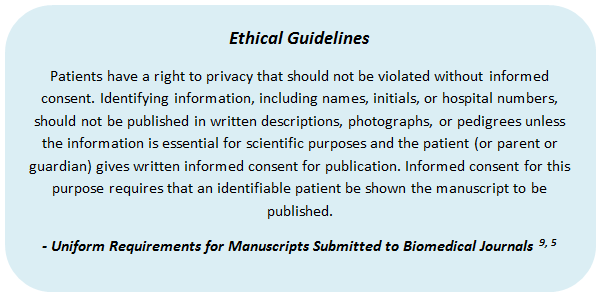Informed consent

You’ve completed a study about AIDS prevalence in Africa, and you feel the need provide your readers with a better idea of the patients you studied. So, you include in your manuscript a photograph of a smiling young boy (and a caption mentioning the disease he had), taken during your fieldwork. What’s wrong with doing this?
One such article was published in the Canadian Medical Association Journal (CMAJ) in April 1998.1 It attracted strong criticism from a reader, 2 who wondered whether the parent or guardian of the boy had consented in writing to the publication of the photo (and the violation of confidentiality that this publication involved). The reader went on to question whether this violation was essential for scientific purposes. Subsequently, the editor-in-chief of CMAJ published an apology for having “goofed and published not only information about a patient’s case, but also the patient’s picture, although consent had not been obtained.”3
Did you know?


In studies involving human participants, written informed consent is important for the following reasons6:
- These documents serve as a permanent record of details that the participant may wish to know even after they have consented to taking part in the study (e.g., whom to contact if they want to withdraw).
- The information in such documents is more detailed (e.g., telephone and fax numbers) and cannot be effectively conveyed through a conversation with the participant.
- Ethics committees or institutional review boards may not have the resources to monitor the conversations in which consent is sought from the participants. Therefore, written informed consent is often essential for the study to obtain ethical approval from such bodies.
- Informed consent forms can serve as legal documents and can be used as evidence (by either party) in the case of a lawsuit related to the study.
- If participants are made aware of the fact that the researcher is following appropriate ethical practices, they are more likely to trust the researcher, which can lead to long-term benefits. “To put it simply, if we cannot guarantee sound research in general—and patients’ safety in particular—public support for gene therapy and other potentially lifesaving treatments will evaporate. Volunteers will not show up”.7
- Those who want to use the data for the participants later (e.g., for a follow-up study) could use these documents to obtain the contact details of the participants.
Failure to obtain informed consent at the beginning of your study can be very costly. For instance, in one case in the US, over 5 million blood samples had to be destroyed because informed consent had not been taken. 8

Moreover, many reputed journals consider failure to obtain informed consent sufficient grounds for rejecting a manuscript. For instance, the American Journal of Psychiatry states, in its guidelines for authors: “If your submission does not contain written informed consent or Institutional Review Board approval, it will not be reviewed.”10 Other journals like the Journal of the American Medical Association require that the Methods section of a paper mentions the formal review and approval/waiver by an appropriate institutional review board or ethics committee.11
In conclusion, obtaining and reporting informed consent are essential for your research and manuscript respectively. Doing so establishes your credibility as a scientist and writer. At present, journal editors “will not publish a manuscript, however scientifically or educationally worthy, when anonymity cannot be absolutely guaranteed or informed written consent has not been obtained.”2
Other reading:
- The Declaration of Helsinki- A statement of ethical principles for medical research that involves human subjects- http://www.wma.net/en/30publications/10policies/b3/17c.pdf
- Uniform Requirements for Manuscripts Submitted to Biomedical Journals- A set of guidelines on the ethical requirements of manuscripts submitted to biomedical journals- http://www.icmje.org/#sthash.P0G1GkvL.dpuf
- Publication Manual of the American Psychological Association, Sixth Edition- Provides a detailed description of the rights and confidentiality of research participants, particularly in the case of the behavioral sciences- http://www.apa.org/pubs/books/4200066.aspx
- The Council of Science Editors’ White Paper on Promoting Integrity in Scientific Journal Publications- A list of examples of actions that constitute mistreatment of research subjects- http://www.councilscienceeditors.org/i4apages/index.cfm?pageid=336
- American Medical Association Manual of Style- Includes guidelines on ethical and legal considerations in preparing an article for publication in a medical journal- http://www.amamanualofstyle.com/view/10.1093/jama/9780195176339.001.0001/med-9780195176339-chapter-5#sthash.P0G1GkvL.dpuf
Bibliography
- Rasid, M. (1998). AIDS in Africa: A personal experience. Canadian Medical Association Journal, 158(8). 1051–1053. Available at https://www.ncbi.nlm.nih.gov/pmc/articles/PMC1229229/
- Barnes, R. (1998). Confidentiality in medical publishing. Canadian Medical Association Journal, 159(5). 443. Available at http://www.ncbi.nlm.nih.gov/pmc/articles/PMC1229634/pdf/cmaj_159_5_443.pdf
- Hoey, J. (1998). Patient consent for publication—an apology. Canadian Medical Association Journal, 159(5). 503–504. Available at http://www.ncbi.nlm.nih.gov/pmc/articles/PMC1229651/pdf/cmaj_159_5_503.pdf
- Pedroni, J. A., & Pimple, K. D. (2001). A Brief Introduction to Informed Consent in Research with Human Subjects. Available at http://citeseerx.ist.psu.edu/viewdoc/download?doi=10.1.1.92.6284&rep=rep...
- 59th WMA General Assembly, Seoul. (2008). World Medical Association Declaration Of Helsinki: Ethical Principles for Medical Research Involving Human Subjects. Available at http://www.wma.net/en/30publications/10policies/b3/17c.pdf
- Resnik, D. B. (2009). Do informed consent documents matter? Contemporary Clinical Trials, 30(2). 114–114. doi: 10.1016/j.cct.2008.10.004. Available at http://www.ncbi.nlm.nih.gov/pmc/articles/PMC2670580/
- Shalala, D. (2000). Protecting research subjects—what must be done. New England Journal of Medicine, 343(11) 808–810.
- Akst, J. (2009). Consent issues nix blood samples. The Scientist. Available at http://www.the-scientist.com/?articles.view/articleNo/27876/title/Consent-issues-nix-blood-samples/
- International Committee of Medical Journal Editors. Uniform Requirements for Manuscripts Submitted to Biomedical Journals: Ethical Considerations in the Conduct and Reporting of Research: Privacy and Confidentiality. Available at http://www.icmje.org/recommendations/browse/roles-and-responsibilities/protection-of-research-participants.html
- The American Journal of Psychiatry. Guidelines For Authors On Preparing Manuscripts. Available at http://ajp.psychiatryonline.org/ajp_ifora.aspx
- Journal of the American Medical Association. Instructions for Authors. Available at http://jama.jamanetwork.com/public/InstructionsForAuthors.aspx
- Levine, S. B., & Stagno, S. J. (2001). Informed consent for case reports: The ethical dilemma of right to privacy versus pedagogical freedom. Journal of Psychotherapy Practice and Research, 10. 193–201. Available at http://www.ncbi.nlm.nih.gov/pmc/articles/PMC3330645/
Published on: Oct 17, 2013
Comments
You're looking to give wings to your academic career and publication journey. We like that!
Why don't we give you complete access! Create a free account and get unlimited access to all resources & a vibrant researcher community.

Subscribe to Conducting Research













